
Merseyrail is a commuter rail network which serves Merseyside and adjacent areas of Cheshire and Lancashire. Merseyrail serves 69 stations, 67 of which it manages, across two lines – the Northern Line and the Wirral Line. The network uses 750 V DC third rail electrified lines having 75.0 miles (120.7 km) of routes, of which 6.5 miles (10.5 km) are underground. Since January 2023, Merseyrail commenced replacing its train fleet, withdrawing the Class 507 and 508 trains and introducing 53 new Class 777 trains. The network carried 25.5 million passengers in the 2022/2023 statistical period.

The Mersey Railway was the passenger railway connecting the communities of Liverpool, Birkenhead, England. It is currently a part of the Merseyrail network. It was extended further into the Wirral Peninsula, which lies on the opposite bank of the River Mersey to Liverpool. Both sides of the river were connected via the Mersey Railway Tunnel. The railway opened in 1886 with four stations using steam locomotives hauling unheated wooden carriages; in the next six years the line was extended with the opening of three more stations. Using the first tunnel under the Mersey, the line is the world's oldest underground railway outside London.

The Wirral Railway was a railway network in the northern part of the Wirral Peninsula, England. Its route was from Birkenhead Park in the east of the Wirral to West Kirby in the west. A branch off this line at Bidston went north to Secombe and New Brighton. It was incorporated in 1863 as the Hoylake Railway, running from Hoylake to Birkenhead Docks. After changes of name and of ownership, it was purchased by the Wirral Railway Company Limited in 1884. The network was extended to West Kirby, New Brighton, and Seacombe, and to Birkenhead Park station where it joined the Mersey Railway, enabling through trains through the Mersey Railway Tunnel to Liverpool. In the 1923 grouping the Wirral company became part of the London, Midland and Scottish Railway, which electrified the line in 1938, allowing passenger services to be integrated with the Liverpool urban system. Most of the Wirral Railway network is still in use today as part of the Wirral Line of the Merseyrail rail network.

The Southern Railway (SR) gave the designation 2-BIL to the DC third rail electric multiple units built during the 1930s to work long-distance semi-fast services on the newly electrified lines from London to Eastbourne, Portsmouth and Reading. This type of unit survived long enough in British Rail ownership to be allocated TOPS Class 401.
The Midland Railway experimented with electrification on its Heysham–Morecambe–Lancaster line in Lancashire, England. Electric trains started to run over this route in 1908, using the overhead 6.6 kV, 25 Hz AC electric supply installed and generated at the MR's own power station in Heysham.
The Lancashire and Yorkshire Railway (LYR) built suburban electric stock for lines in Liverpool and Manchester. The line between Liverpool to Southport began using electric multiple units (EMUs) on 22 March 1904, using a third rail 625 V DC. Additional trains were later built for this route, and in 1913 incompatible stock for the route to Ormskirk. Lightweight units were built to run on the Liverpool Overhead Railway.

The Wirral line is one of two commuter rail routes operated by Merseyrail and centred on Merseyside, England, the other being the Northern line.

West Kirby railway station serves the town of West Kirby in Merseyside, England. The station is the terminus of the West Kirby branch line, which is one of the two branches of the Wirral Line on the Merseyrail network. There is a central island platform between two terminus tracks and two parallel sidings for out-of-use electric multiple units. A second station, which was the terminus of a branch line from Hooton, lay to the east of the Wirral Line station; it was closed in 1962.
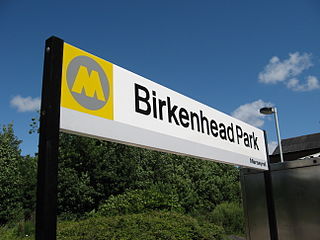
Birkenhead Park railway station is a station serving the town of Birkenhead, in Merseyside, England. It lies on the Wirral Line of the Merseyrail network.

Birkenhead North railway station serves the town of Birkenhead, in Merseyside, England. The station is situated on the Wirral Line of the Merseyrail network, close to the junction of the New Brighton and West Kirby branches. Birkenhead North TMD, situated just to the west of the station, is the main traction maintenance depot for the Merseyrail fleet.

An electric multiple unit (EMU) is an electric self-powered train, capable of operating in multiple with other EMUs and without the need for a locomotive; these are typically passenger trains with accommodation in every vehicle and a driving position at each end. The term can also be used to describe a train that is a permanent formation with a non-driving power car, such as the Advanced Passenger Train. As of December 2010, two-thirds of the passenger carriages in Great Britain are formed in EMUs.

British Rail Class 503 passenger trains were 65 mph (105 km/h) electric multiple units. They were introduced in two batches: the first were in 1938, by the London, Midland and Scottish Railway (LMS), with a further batch in 1956 by the then nationalised British Railways (BR). When introduced by the LMS, they were known officially as Class AM3. They were designed for, and operated on, the Wirral & Mersey lines from Liverpool to West Kirby, New Brighton and Rock Ferry. There were few places on their network of closely-spaced stations to attain their maximum speed, except for the open section between Moreton and Meols. All but one set were withdrawn and scrapped by 1985. The final set was used on special Merseyrail services until 1988; it was preserved and kept at the Electric Railway Museum near Coventry, until it moved on to the Locomotive Storage Ltd warehouse at Margate.

The British Rail Class 502 was a type of electric multiple-unit passenger train, originally built by the London, Midland and Scottish Railway at its Derby Works. Introduced in 1940 and withdrawn by 1980, they spent the whole of their working lives on the electrified railway lines north of Liverpool.

British Railways Class 505 were 1,500 V DC electric multiple units (EMUs) introduced in 1931 by the Manchester, South Junction and Altrincham Railway (MSJAR). Although assigned to TOPS Class 505 by British Railways, these units were withdrawn before the TOPS numbering system came into common use for multiple units, and the Class 505 designation is very rarely used.
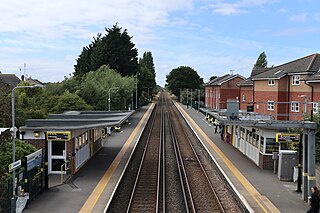
Leasowe railway station is a station serving the village of Leasowe, in Merseyside, England. It lies on the West Kirby branch of the Wirral Line, part of the Merseyrail network.
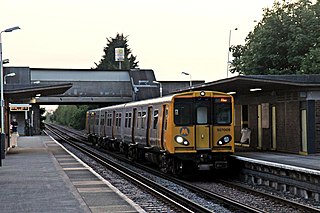
Moreton railway station serves the town of Moreton, in Merseyside, England. The station is on the West Kirby branch of the Wirral Line, which is part of the Merseyrail network.
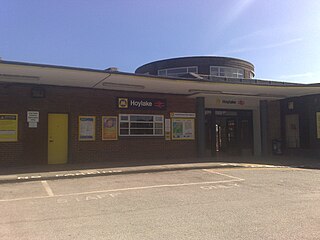
Hoylake railway station serves the town of Hoylake, Merseyside, England. It lies on the West Kirby branch of the Wirral Line, part of the Merseyrail network.
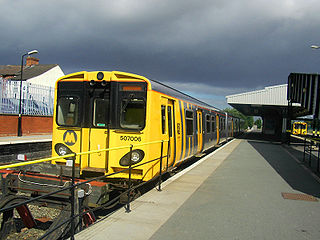
Rock Ferry railway station is situated in the Rock Ferry area of Birkenhead, Merseyside, England. The station lies 4.5 miles (7 km) south west of Liverpool Lime Street on the Chester and Ellesmere Port branches of the Wirral Line of the Merseyrail network. The station has an island platform with four platforms in total and four tracks.

Metropolitan Railway electric multiple units were used on London's Metropolitan Railway after the lines were electrified in the early 20th century.

The LMS electric units were built in 1926–32 by the London, Midland and Scottish Railway (LMS) for use on the Liverpool to Ormskirk line and the DC lines in north London, all in England. Having inherited systems with DC electrification, the LMS built a number of new 3-car electric multiple units. The trains were withdrawn in 1963 and 1964.


















